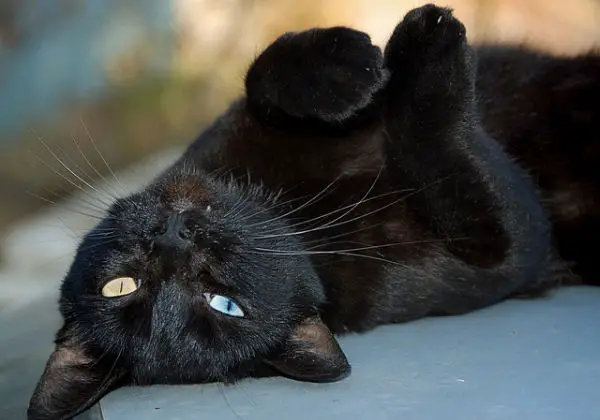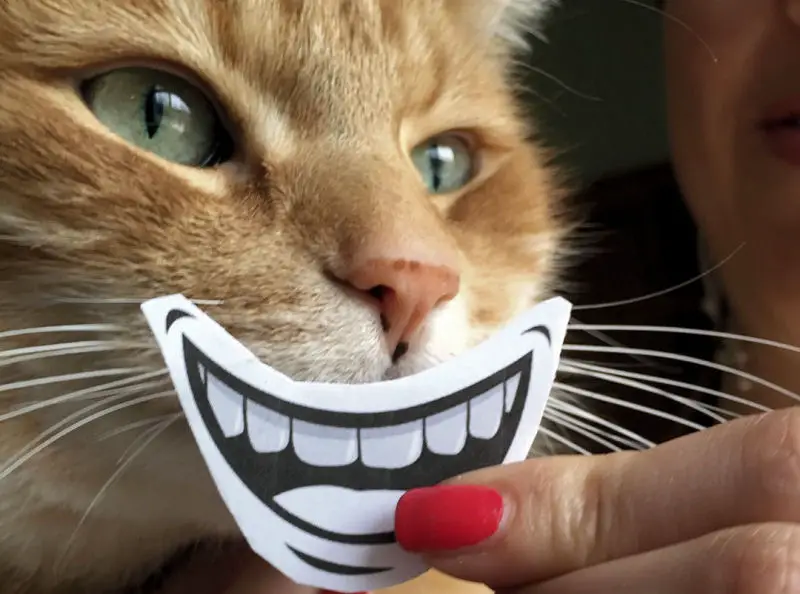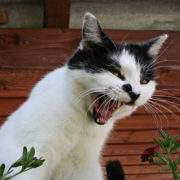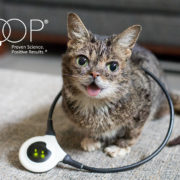The Purr:
Did you know that cats (both large and small) are the only animals that purr? A cat’s purr begins in its brain when a neural oscillator sends messages to the laryngeal muscles, causing them to twitch at a rate of 25 to 150 vibrations per second. This causes the vocal cords to separate when the cat inhales and exhales, producing a purr. Cats can purr both on inhaled and exhaled breaths, with their mouths completely closed.

For kittens (who can’t see or hear), the vibration of their mother’s purring can be felt, acting as a homing device, an indication for them to feed When a cat purrs, it isn’t always out of pleasure; a deep purr can also be an indicator of pain or distress.
Cats’ purrs might be more than just a way to communicate – some scientists believe that cats also purr to heal themselves. Purring isn’t just good for cats though — it’s also healthy for cat owners. Studies show that cats do a better job of relieving stress and lowering blood pressure than other pets. A 10-year study at the University of Minnesota Stroke Center found that cat owners were 40 percent less likely to have heart attacks than non-cat owners — and purring might play a role in that. Read more here about the healing power of a cats’ purr.
Up next…the Meow…




There really is a lot more to cats than meets the eye. Listen to what they say and learn.
My cats have taught me a lot about life and what’s truly important. They are wise creatures.
If I’ve learned a lesson from my cat (Chester) – it’s that the present moment is all we have. Cats aren’t scrambling to meet a deadline or race the clock. Sometimes it’s wise to stop and smell the roses.
My cat always believes in the principle of ‘why do today what can wait until tomorrow’ 🙂
Something I learned from my cat – she will always seek out the sunniest, warmest spot in the house to sleep the day away.
My cat Simon has at least 5 different types of meows. I can understand each and ever one of them now.
I have regular conversations with my Persian (Samantha)
Been watching my cats tail after reading this – mostly upright…means she adores me I assume. 🙂
Thank you for sharing this. I adore my sweet cat. Now I can understand her vocalizing.
Love cats..have 3 in my home.
My sweet Lola would talk to me. I would meow and she always answered. She would come into the bathroom while I was either in the shower or tub. Walk around meowing so loud and actually stand or sit on the edge and talk to me while I bathed. It was the best part of my day.
I listen to what they say, and love all 3 of them for the wonderful friends they are,
and thank them for the lessons they have taught me.
My old man Sox who is 16 years old has recently started getting in my lap. Love it.
We talk all the time he meows and I meows back. I always know what he talking about, my boyfriend says I crazy lol.
Cats are wonderful and adoring creatures. My grandcat Fiona Glenn Anne is a loveable and quirky girl. She will let you know what and when she wants it! Every time I see her she rubs her face gently all over mine. Cats have scent glands in their face she makes sure everyone knows I belong to her!
Hi there,
I have a cat name Mickey Jr. Mickey is my brid and
Joel to me. He always tells me went he wants his wet food. There a time when he wanted to go out side. I tell him no and he meow back to me.
My eldest cat has a large vocabulary compared to other cats I know. He makes dozens of different sounds all with their own unique meaning.
Fell out of bed feeling down. This has brehitgned my day!
Very true! Makes a change to see soneome spell it out like that. 🙂
We loved our amazing, giant Tabby cat and Since he was the quintessential absolutely perfect everything a Tabby Cat could or should look like and be like, we called him TABBY! The largest and Most beautiful cat I have ever seen! We loved him and he loved us back in his natural, regal and always dignified manner. He amazed everyone who met him. He acquired feline leukemia as a young adult and though we did have a vet who followed him and prescribed meds, Tabby passed away before he reached middle age. We lost him but we will never forget him🐾💕
Love cats..have 5 in my home.